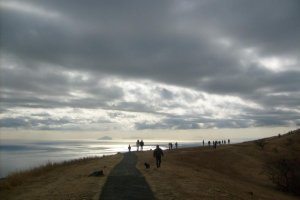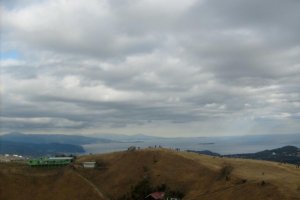The Izu Peninsula is famous for its hot springs, provided with steaming hot water by the region's volcanic geology. Mount Fuji is the most famous volcano, but it's not the only one in the vicinity: close to Ito on the peninsula's east coast is Mount Omuro, an extinct volcano that makes for a pleasant half-day excursion.
At 580m high, Omuro is the highest peak in the area, and there's no path: you're carried to the top in a fun few minutes in a rickety-looking (but presumably safe) chairlift. The first things you find when you get there are a lookout point and Sancho-Baiten, a small shop where you can buy snacks and souvenirs. I decided to do my shopping later, and set off straight away along the circular trail around the crater rim, which gives a striking, complete panorama in every direction. The weather wasn't so kind to me when I was there, but on a clear day I'd have had a fine prospect south down the peninsula and out across the ocean to the Izu islands. Facing north, I'd have been able to enjoy a view of Mount Fuji and, far in the distance, the snow-capped Southern Alps.
During the year there are a handful of special events to attract visitors. On New Year's Day the chairlift starts running from 5:40am for the first sunrise of the year, and on the second Sunday of February each year, the dead grass is burnt off the mountainside to allow the new buds of spring to peek out. The arc of fire advancing around the mountain, leaving smoking burnt grass in its wake, is quite a spectacle.
It's also possible to enjoy a couple of sporting activities while you're there. Down in the crater there's an archery range where wannabe Robin Hoods can try their hands, while the more adventurously inclined can try paragliding from the trailside.
If you forget to buy your souvenirs before you ride the chairlift back to the bottom, there are more shops for you to browse when you get there, selling the usual assortment of trinkets and confectionery, as well as locally produced sake, candy and other goods. There's also a small café where you can get snacks or light meals or, across the road, a more up-market restaurant which has decent value lunch sets.

































